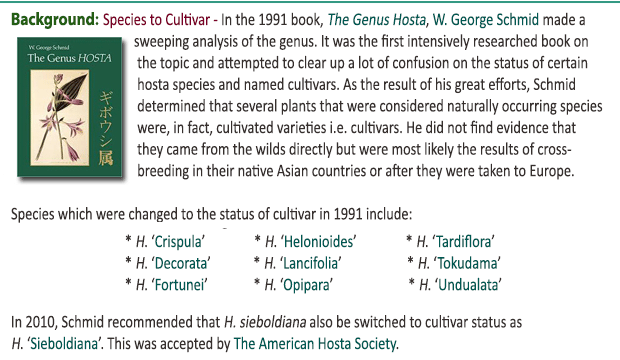
 In 1937,
Dr. Fumio Maekawa first described this plant from
Japan and
named it as a species, Hosta opipara. It was changed to
cultivar status in
The Genus Hosta by W. George Schmid (1991) and is correctly known
as H. 'Opipara'. Subsequently,
The American Hosta Society registered the cultivar on behalf of Dr. Maekawa in 2002. In 1937,
Dr. Fumio Maekawa first described this plant from
Japan and
named it as a species, Hosta opipara. It was changed to
cultivar status in
The Genus Hosta by W. George Schmid (1991) and is correctly known
as H. 'Opipara'. Subsequently,
The American Hosta Society registered the cultivar on behalf of Dr. Maekawa in 2002.
The plant forms a
large size, rhizomatous
mound about 19 inches tall by 40 inches wide. Its foliage is
dark green in color with a creamy white marginal variegation. They
are ovate-shaped, wavy and have above average substance. It
bears medium purple flowers in August and sets viable seeds.

 There seems
to be a lot of confusion over this fine hosta as
evidenced by the following comments from
The Hostapedia by
Mark Zilis (2009).
It appears that he is saying that H. 'Opipara' is
actually H. 'Bill Brincka' but it could also be H. 'Koriyama' which could be H. 'Opipara Koriyama'
which is the same as H. 'Mishima Fukurin Koba'...is
that clear? There seems
to be a lot of confusion over this fine hosta as
evidenced by the following comments from
The Hostapedia by
Mark Zilis (2009).
It appears that he is saying that H. 'Opipara' is
actually H. 'Bill Brincka' but it could also be H. 'Koriyama' which could be H. 'Opipara Koriyama'
which is the same as H. 'Mishima Fukurin Koba'...is
that clear?
RE: H. 'Opipara' - Mark Zilis (2009) says,
"...'Opipara' (or 'Bill Brincka') should be in every hosta
collection...In the 1980s, however, I would not have given this
plant such a glowing recommendation. Nearly every plant of 'Opipara'...in
the United States was infected with a virus (probably
Hosta Virus X). Fortunately,
Bill Brincka... obtained
a clean selection of this plant, which was marketed under his
name..."
RE: H. 'Koryama' - According to
The Hostapedia by Mark Zilis (2009), "When I first encountered this
plant in the 1980s, it was purported to be a dwarf-size
Hosta opipara, listed as
Hosta opipara 'Koriyama'. A
lot has changed since that time. Hosta opipara is now considered
a cultivar (H. 'Opipara') and 'Koriyama' is the proper spelling
for the plant (named for a mountain in northeastern Japan). More
importantly, 'Koriyama' appears to be the same as 'Mishima
Fukurin Koba', a form of Hosta sieboldii!"
RE: H. 'Bill Brincka'
- Mark Zilis (2009) states,
"...represents a
virus -free
version of 'Opipara'. Most 'Opipara' specimens in the U.S. were
infected with a virus (probably
Hosta Virus X) before
Bill Brincka imported this clean plant from
Japan. By whatever name,
the plant is simply magnificent."
Mikiko Lockwood in an article on The Hosta Library titled,
A Little About Japanese Hosta Terms defines the term koba as small leaf,
'Koba Gibōshi' or
H. sieboldii and the term fukurin as margined or edged.


In
The
Hosta Journal (1985 No. 16)
Warren I. Pollock
related the following from a 1984 correspondence with a
former associate of Dr. Maekawa. "I must heartily
congratulate Mrs. Noriko Clement...for deciphering the
late Dr. F. Maekawa's clever use of the Latin word
opipara as a 'combination' of the two Japanese words
'obi (opi)' and 'bara (para)'. Apparently
Dr. Maekawa, in his assigning Hosta nomenclature, used
the name opipara (Latin for sumptuous) for his
most sumptuous and favorite variegated hosta. I remember
being in a group discussing Hosta taxonomy with
him. He mentioned how beautiful and colorful H. opipara
is, and then someone offhandedly remarked that the
bright border is like the colorful sash of a kimono (obi).
A smile came on Dr. Maekawa's face which clearly
indicated to me: 'Yes, that's correct. But, oh! Now
you've discovered my little play-on-words.' His Japanese
name for H. opipara is another clue. 'Nishiki'
means brocade, e.g. material used for a sash."
An Editor's note in
The
Hosta Journal (2010 Vol. 41 No. 1) states that, "H. 'Bill Brincka' is a selection of 'Opipara', but without the virus that plagues
many 'Opipara' plants. When Bill Brincka brought his fabulous leaves of the
plant he called 'Bill Brincka' to the
National Convention of
The American Hosta Society Hosta Show in Jackson,
Michigan, in 1988, it had been feared that all 'Opipara' plants were
virus-infected, but his clearly was not."
A Photo Essay article by Steve Chamberlain in
The
Hostta Journal (2010 Vol. 41 No. 1) makes comments about
H. 'Bill Brincka', "
William Brincka registered this selected clone of 'Opipara'
in 1988. Although it has leaves of a size appropriate for a medium-sized hosta,
it is strongly stoloniferous (Mr PGC - Hostas are rhizomatous) and forms
a very large plant as it matures. The shiny green leaves emerge with a bright
yellow margin that slowly lightens to white as the season progresses..."






|



